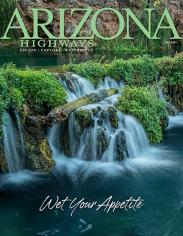Decades ago, John Schaefer, who was president of the University of Arizona from 1971 to 1982, asked one bold question of legendary landscape photographer Ansel Adams. It happened on March 17, 1974, during the opening for Adams’ exhibition at the university’s art gallery, and it happened because Schaefer wanted Adams’ archive to live at the school.
Adams was taken aback, at least initially. Schaefer quotes the photographer’s response in his memoir, A Chance to Make a Difference: “Berkeley thinks they’re getting my archive, but they seem to be planning to bury my work in the basement of the Bancroft Library. If you’re serious about this, we should spend some time talking about what might be involved.”
Schaefer later traveled to Adams’ home in Carmel, California. In the days that followed, the men, with the help of Adams’ business manager Bill Turnage, laid the foundation for the Center for Creative Photography, which opened in 1975 with the collections of Adams, Wynn Bullock, Harry Callahan, Aaron Siskind and Frederick Sommer.
Now, as the center celebrates its 50th anniversary, it houses more than 8 million archival objects and 270 collections, including the work of Edward Weston, W. Eugene Smith and Lola Álvarez Bravo. “CCP has become the great American repository of photography,” Schaefer says. “It’s an institution that’s recognized worldwide and visited by people from all over.”
Schaefer remembers Adams as a remarkable human being with a profound social and political conscience. “He really changed the way people perceive the outdoors in America,” he says. “I consider it one of the greatest friendships of my life.”
Special exhibitions at the CCP for the remainder of its anniversary year include Picture Party: Celebrating the Collection at 50 — which includes more than 100 photographs and archival objects — and Pictures for Charis, American photographer Kelli Connell’s exploration of the relationship between Weston and writer Charis Wilson.
“The institution has grown remarkably,” Schaefer says. “It’s become a real asset for the state of Arizona and for photography as a whole. Photography stimulates our understanding of what’s happening in our world, as a catalyst for social change. I hope it will continue to reflect issues of importance to America, and that the archives will serve as a stimulus to our consciousness about what photographs mean and represent to the public.”
TUCSON Center for Creative Photography, 1030 N. Olive Road, 520-621-7968, ccp.arizona.edu

